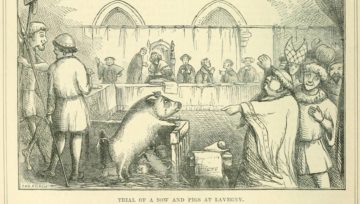Ed Simon in Psyche:
 If you were an animal in need of legal representation in early 16th-century Burgundy – a horse that had trampled its owner, a sow that had attacked the farmer’s son, a goat caught in flagrante delicto with the neighbour boy – then the best lawyer in the realm was Barthélemy de Chasseneuz. Though he’d later author the first major text on French customary law, become an eloquent defender of the rights of religious minorities, and be elected parliamentary representative for Dijon, Chasseneuz is most remembered for winning an acquittal on behalf of a group of rats put on trial for eating through the province’s barley crop in 1522. Edward Payson Evans, an American linguist whose book The Criminal Prosecution and Capital Punishment of Animals (1906) remains the standard work on the subject, explains that Chasseneuz was ‘forced to employ all sorts of legal shifts and chicane, dilatory pleas and other technical objections,’ including the argument that the rats couldn’t be forced to take the stand because their lives were at risk from the feral cats in the town of Autun, ‘hoping thereby to find some loophole in the meshes of the law through which the accused might escape’ like, well, rats. They were found not guilty.
If you were an animal in need of legal representation in early 16th-century Burgundy – a horse that had trampled its owner, a sow that had attacked the farmer’s son, a goat caught in flagrante delicto with the neighbour boy – then the best lawyer in the realm was Barthélemy de Chasseneuz. Though he’d later author the first major text on French customary law, become an eloquent defender of the rights of religious minorities, and be elected parliamentary representative for Dijon, Chasseneuz is most remembered for winning an acquittal on behalf of a group of rats put on trial for eating through the province’s barley crop in 1522. Edward Payson Evans, an American linguist whose book The Criminal Prosecution and Capital Punishment of Animals (1906) remains the standard work on the subject, explains that Chasseneuz was ‘forced to employ all sorts of legal shifts and chicane, dilatory pleas and other technical objections,’ including the argument that the rats couldn’t be forced to take the stand because their lives were at risk from the feral cats in the town of Autun, ‘hoping thereby to find some loophole in the meshes of the law through which the accused might escape’ like, well, rats. They were found not guilty.
Dismissing animal trials as just another backwards practice of a primitive time is to our intellectual detriment, not only because it imposes a pernicious presentism on the past, but also because it’s worth considering whether or not the broader implications of such a ritual don’t have something to tell us about different ways of understanding nonhuman consciousness, and the rights that our fellow creatures deserve.
More here.
